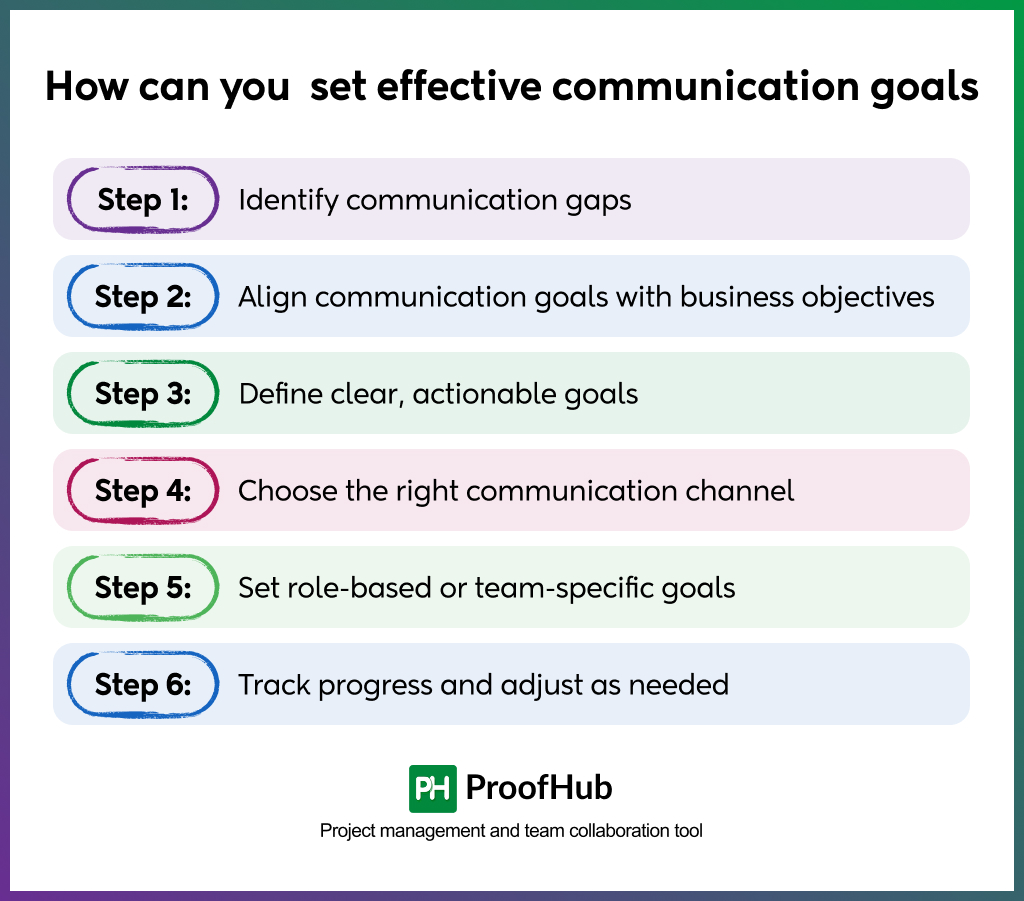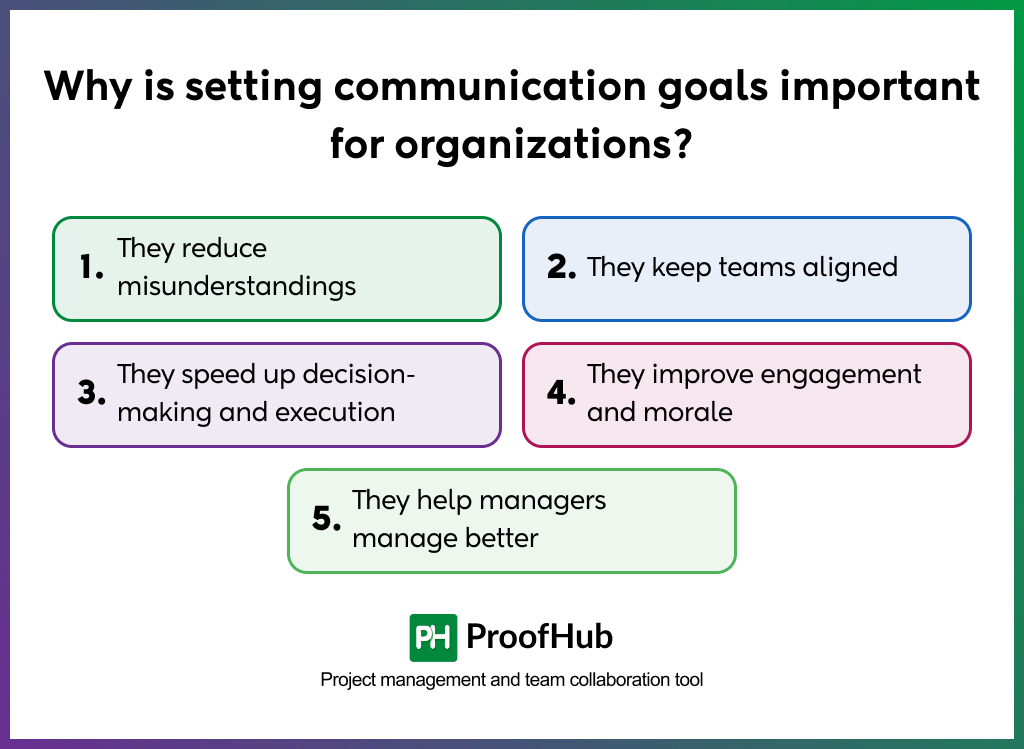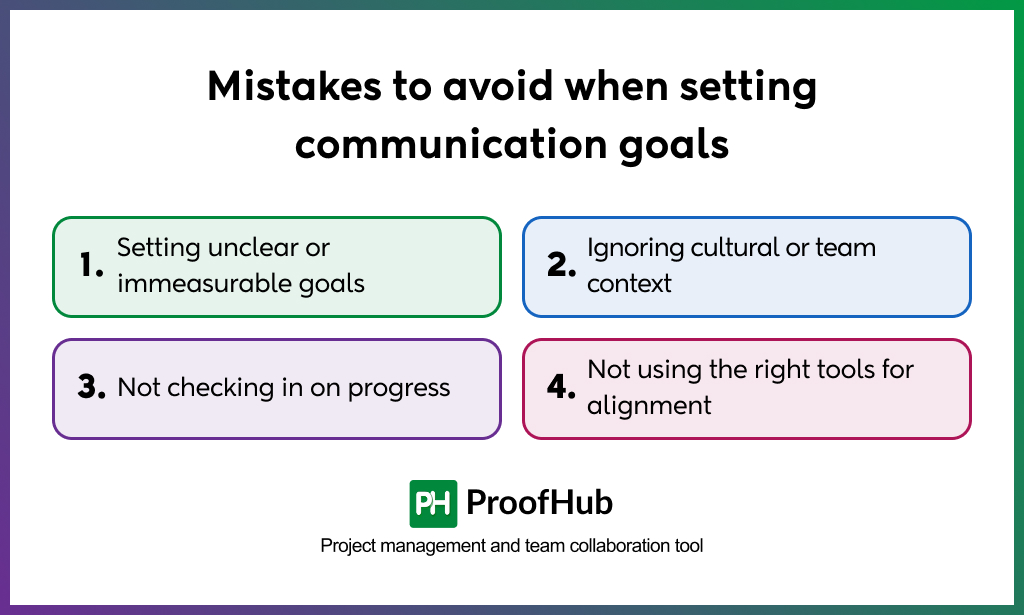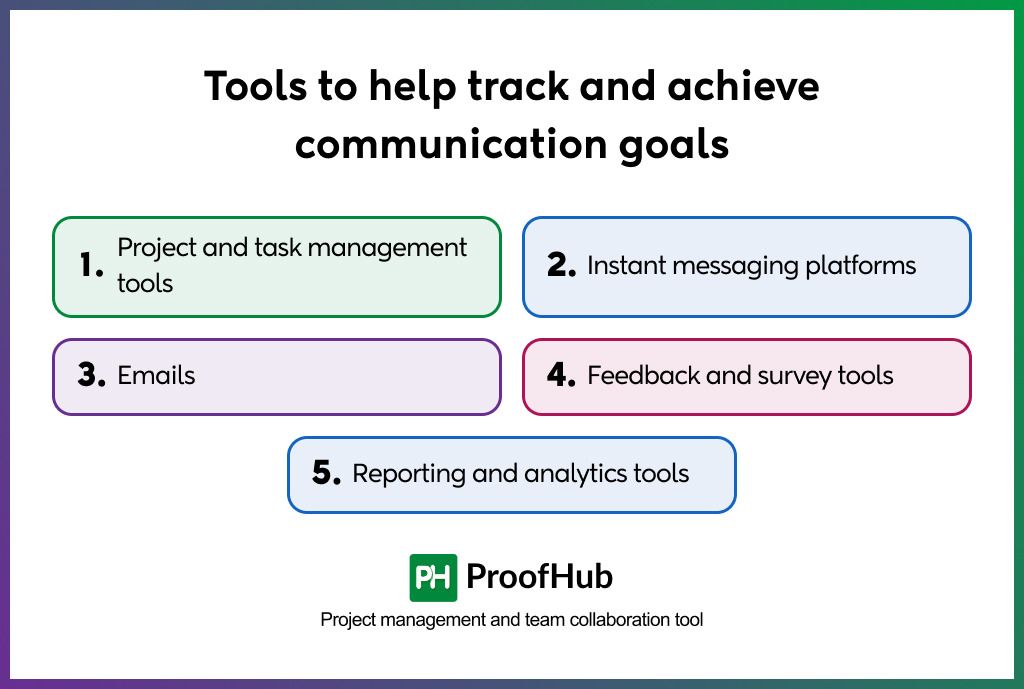Messages are overlooked. Updates remain unshared. Teams proceed based on assumptions, only to revisit issues when something is missed. These are not isolated incidents. They are symptoms of unstructured communication.
That’s why you need communication goals. They offer a simple, structured way to bring clarity, consistency, and purpose to everyday interactions. Whether you’re leading a project or managing a remote team, setting clear communication goals can reduce confusion and drive progress.
In this article, I will walk you through what communication goals are and how to set them in the workplace. You will also explore examples and mistakes that you should avoid.
So, without further ado, let’s get started.
What are communication goals in the workplace?
Communication goals in the workplace are clear, measurable objectives that define how information should be shared, received, and understood within a team or organization. They make sure that every interaction, whether it’s a meeting, email, or message, has a clear purpose and supports work outcomes.
Rather than communicating reactively or at random, these goals help teams exchange the correct information, at the right time, in the right way, so messages are not just delivered, but understood and acted upon.
Unlike communication skills or strategies, communication goals focus on results. They answer questions such as:
- What should this message achieve?
- How will we know if it worked?
- Is the way we communicate moving us toward team or business objectives?
When communication goals are well-defined, they connect the intent and action, allowing teams to collaborate more effectively and avoid misunderstandings.
How can you set effective communication goals
Before setting any communication goal, you need to understand what is not working. Here is a comprehensive breakdown of each way to set effective communication goals in the workplace, along with practical steps and examples:

Step 1: Identify communication gaps
This means understanding specific communication issues that are affecting team performance.
Start by observing team behavior. Are project updates shared too late or often inconsistent? Do team members usually miss important instructions? Are meetings unproductive or lacking follow-up? Is cross-functional communication scattered or unclear? Do clients complain about delayed or vague responses?
To identify, use tools like anonymous surveys, one-on-one feedback sessions, and project retrospectives. You can even ask team members where they feel communication breaks down and impacts their work.
Remember, you can’t improve what you haven’t identified. Many workplace issues, such as missed deadlines, low morale, or misunderstandings, originate from poor communication. Unless you recognize the exact challenges, your goals will lack direction.
Step 2: Align communication goals with business objectives
This means aligning all communication goals that directly support your team’s broader goals that ultimately lead to the company’s overall mission.
Start by revisiting your team’s key performance indicators (KPIs) or company’s strategic priorities. Here, emphasis is on finding the bigger picture, whether you are aiming to improve client satisfaction, shorten project timelines, or build stronger cross-functional collaboration.
Once everything seems connected, set goals that help you close the gap between poor communication and missed targets. For example, if project delivery is delayed due to unclear task assignments, a goal could be to improve clarity in task.
What matters most is that communication is not just a soft skill; it is a business tool. And when your goals are aligned with larger business outcomes, they become more relevant and impactful.
Step 3: Define clear, actionable goals
Once you know the issue, define the outcome you want. Clearly state what improved communication will be for your team, whether it is consistent status updates or quick task responses. To make communication goals effective, you can use the SMART framework, which makes sure that each goal is:
- S – Specific: What exactly do you want to achieve?
- M – Measurable: How will you track progress or success?
- A – Achievable: Is the goal realistic given your team’s capacity and tools?
- R – Relevant: Does it support your team or project goals?
- T – Time-bound: What’s the deadline or timeline?
Here are a few examples of how SMART goals are structured:
| Vague Goal | SMART Goal |
| Be more responsive to messages | Reply to internal messages within 6 working hours during weekdays for the next 30 days |
| Improve transparency | Share weekly team progress updates in a public discussion thread every Friday for the next 2 months |
| Fix communication issues during handoffs | Create a standardized project handoff checklist and use it in 100% of transitions starting this quarter |
SMART goals make it easier to track progress by eliminating confusion and creating focus. When people know what’s expected, how it will be measured, and when to deliver, they’re more likely to take consistent action.
Step 4: Choose the right communication channel
This means using the right communication tools that align with your team’s workflow and support your goals.
Start by reviewing the tools your team currently uses. Are conversations scattered across too many platforms? Are tools being used inconsistently? Using the wrong tool often creates more confusion than clarity. The right channel reduces message loss and improves message clarity.
| Purpose | Best channel |
| Quick updates or questions | Instant messaging |
| Formal announcements | Emails, announcements in tools like ProofHub |
| Task-related updates | Project management tools |
| Sensitive or in-depth discussions | 1-on-1 video calls or team meetings |
| Cross-team visibility | Shared discussion boards or reports |
Even with the best intentions, communication goals fail when the tools don’t support the behavior. Having the right tools creates consistency, structure, and clarity, making it easier to collaborate and stay on track.
Pro tip: If your team uses too many platforms, part of the goal could be to streamline communication into one tool for visibility and consistency.
One such tool is ProofHub – an all-in-one project management and collaboration tool – that gives your team one place for announcements, task-related discussions, document sharing, and status updates, without switching between multiple apps.
Step 5: Set role-based or team-specific goals
This means customizing communication goals based on the unique responsibilities, workflows, and communication styles of different roles or teams. Not every goal should apply to everyone in the same way. You can customize communication goals by role and make them more relevant and actionable.
For example:
| Role | Communication goal |
| Managers | Conduct bi-weekly 1-on-1 check-ins with direct reports and record 3 key takeaways each time for the next quarter. |
| Project Teams | Share task progress updates by Friday EOD every week on the shared board for the next 6 weeks. |
| Sales Team | Log every client call with follow-up action items in CRM within 12 hours for the next month. |
| Marketing and Sales Teams (Cross-functional) | Host a shared campaign update meeting every 2 weeks to align messaging and timelines. |
Then create specific, outcome-driven goals based on their goals. These goals should focus on improving daily communication habits and processes.
Role-based goals increase ownership and remove ambiguity in responsibilities.
Step 6: Track progress and adjust as needed
This step focuses on monitoring how well your communication goals are being followed. Setting goals is not enough; you need to track them – how they’re working and make improvements along the way.
What do you need to track?
- Are updates being shared consistently and on time?
- Are team members meeting response time expectations?
- Are meetings more productive and followed by action?
- Are people using the right tools as intended?
Here is how you can track communication goals:
- Use analytics from tools (such as message open rates, response times)
- Run brief feedback check-ins or surveys
- Review task comments, updates, or announcements in your project management tool
- Use reminders, recurring checklists, or automation
You need to adjust when:
- A goal isn’t realistic
- The channel isn’t working
- Participation is dropping
- Feedback shows confusion or friction
Why is setting communication goals important for organizations?
In any workplace, communication happens constantly through emails, meetings, or chats. But without direction, it often results in confusion, delays, and wasted effort. Setting clear communication goals brings structure and intention to these everyday exchanges.

Here’s why setting communication goals is important for your organization:
- They reduce misunderstandings
When team members aren’t sure what to share or when to respond, important details get missed. Communication goals clarify what’s expected, such as updating progress every Friday or responding to messages within a set timeframe, so everyone stays on the same page. This results in fewer miscommunications and less time spent fixing avoidable mistakes.
- They keep teams aligned
In complex projects or remote setups, team alignment is essential. Communication goals make sure that updates, feedback, and instructions support shared priorities. This avoids the common problem of teams working in different directions without realizing it.
- They speed up decision-making and execution
When communication is consistent and purposeful, teams don’t waste time chasing updates or waiting for approvals. They know what’s happening and what to act on. For instance, you can set a goal to summarize and share meeting notes within an hour, making sure that no one waits for next steps.
- They improve engagement and morale
Employees are more involved when they know what’s going on and are encouraged to contribute. Communication goals around feedback or recognition build a culture of inclusion and trust.
- They help managers manage better
Managers rely on clear, timely, and effective communication to guide their teams. Communication goals provide checkpoints, whether it’s tracking progress, identifying blockers, or sharing changes, so managers can take action before small issues grow into bigger problems.
Mistakes to avoid when setting communication goals
Even with the best intentions, communication goals can fail if they are not planned well. Here are some common mistakes that derail team communication and how you can avoid them:

- Setting unclear or immeasurable goals
Goals like “communicate more clearly” or “keep everyone in the loop” don’t give your team anything specific to aim for. They’re open to interpretation and hard to track.
How to avoid this mistake?
Always make communication goals measurable and result oriented. Use timelines, frequencies, or target percentages (e.g., “Share weekly updates every Friday by 4 PM for the next 2 months”). The SMART framework can help you bring clarity and structure.
- Ignoring cultural or team context
A communication style that works for one team may not work for another. Setting goals without considering team dynamics, language preferences, or time zones can create friction rather than alignment.
How to avoid this mistake?
Adapt your communication goals to your team’s culture, tools, and workflows. For example, if your team works asynchronously across time zones, make goals around documentation and response windows, not instant replies.
- Not checking in on progress
Setting a goal and then forgetting about it can lose momentum. Without regular follow-up, people stop prioritizing the goal and nothing changes.
How to avoid this mistake?
Schedule regular check-ins to review progress. Use weekly reviews, pulse surveys, or short sync-ups to assess what’s working and what needs to change.
Even a 5-minute review can help you keep everyone aligned, identify small issues before they escalate, and maintain momentum toward goals.
- Not using the right tools for alignment
A well-defined goal can also fail, if not visible or reinforced through the tools your team uses every day. Relying on scattered communication platforms makes it easy for updates to get missed.
How to avoid this mistake?
Centralize communication using tools such as ProofHub that support goal tracking. In ProofHub, for instance, you can use task comments, announcements, and custom workflows to make sure everyone stays on the same page without switching tools.
Avoiding these mistakes only takes better planning. When communication goals are clear, contextual, and supported by the right tools, they offer clarity and accountability among team members.
Tools to help track and achieve communication goals
Setting communication goals is one thing but achieving them consistently is another. To do that, you need tools that help your team stay aligned and track progress consistently.

Here are some common tools that can help you track and achieve communication goals in the workplace:
- Project and task management tools: These tools help teams organize work, track progress, and keep communication connected to specific tasks or projects, making it easier to stay aligned without chasing information.
- Instant messaging platforms: Messaging apps let you exchange information in real time and are ideal for quick clarifications or informal updates.
- Emails: Emails are effective for formal messages, summaries, and communication with executives or external stakeholders. They work well for sharing company-wide updates or following up after meetings.
- Feedback and survey tools: Feedback tools allow managers to run quick surveys, gather opinions on meetings or internal updates, and identify areas where communication is unclear or ineffective.
- Reporting and analytics tools: Tools with analytics features can help you observe how frequently updates are shared, whether messages are being read, how long responses take, and how engaged teams are.
Rather than relying on separate tools for tasks, updates, reminders, and team discussions, a centralized platform such as ProofHub brings everything together.
ProofHub is an all-in-one project management and team collaboration tool that simplifies communication, especially for teams working on multiple projects and priorities. It brings clarity, structure, and accountability to everyday collaboration – all in one place.
Here is how ProofHub can help you track and achieve your communication goals:
- Centralized team discussions: Create topic-specific threads to keep conversations organized and visible to the right people.
- @mentions and announcements: Tag team members to grab their attention instantly, or use announcements to broadcast important updates company-wide.
- Task comments and file sharing: Keep feedback and files tied to specific tasks so that everyone knows where to find what they need without any back-and-forth.
- Time-bound reminders: Set recurring reminders to share updates, check in on progress, or follow up on communication goals.
- Easy visibility across teams: Whether it’s marketing, HR, or client-facing teams, ProofHub gives everyone a shared space to collaborate without chaos.
Examples of SMART communication goals
In the workplace, communication goals can have different purposes depending on who’s communicating and why. Here are some common types of communication in a workplace:
- Interpersonal – between two individuals
- Team – within a department or working group
- Managerial – from manager to team member
- Cross-functional – between different departments
- Client-facing – between teams and external clients
Below are five examples of SMART communication goals, organized by above workplace scenarios:
- Interpersonal communication goal
When 1-on-1 conversations are rushed or unclear, misunderstandings can build up over time.
Example: Summarize the key takeaways at the end of every 1-on-1 meeting for the next 4 weeks.
This makes sure that both people walk away with the same understanding and reduces repeated clarification.
- Team communication goal
When teams don’t know the project status, they often assume, causing priorities to shift or deadlines to be missed.
Example: Share project updates every Friday by 4 PM via team announcements for the next 6 weeks.
This builds a consistent rhythm for updates and keeps everyone on the same page, without having to ask.
- Managerial communication goal
Without regular feedback or direction from managers, team members may feel unsupported or unsure of expectations.
Example: Conduct weekly 1-on-1 check-ins with direct reports and log at least 3 action items after each session for the next quarter.
This provides structure, builds trust, and helps managers track progress more effectively.
- Cross-functional communication goal
When departments are not aligned, there are delayed campaigns or teams make duplicated efforts.
Example: Host a 30-minute sync between marketing and sales teams every two weeks to align on campaign goals for the next 3 months.
This improves coordination and keeps both teams moving toward shared objectives.
- Client-facing communication goal
If clients don’t hear back quickly, trust erodes and small issues can escalate into huge problems.
Example: Respond to 100% of client queries within 12 business hours for the next 30 days.
This sets a clear service standard and reinforces your team’s professionalism.
How to measure communication goals?
To measure communication goals effectively, focus on tracking both engagement and behavioral changes. Here’s how you can do it effectively:
- Use analytics tools to track measurable data including:
- Email open and click-through rates
- Message views on announcements or updates
- Tool usage patterns (e.g., comments, status updates)
- Conduct short pre- and post-surveys to evaluate improvements in team clarity, satisfaction, or responsiveness.
- Track behavioral indicators such as:
- Improved meeting punctuality
- Faster response times to messages
- Reduced need for repeated instructions
- Track communication consistency using project management tools such as ProofHub, which helps you:
- Set reminders for updates
- Track comments and task activity
- Keep communication centralized and visible across teams
By combining qualitative feedback with usage data, you can assess if your communication goals are making any real, measurable improvements.
Can communication goals impact business growth?
Yes, communication goals can impact your business growth. When teams communicate with purpose, projects stay on track and collaboration becomes more effective.
Here’s how communication goals impact your business growth:
- Faster execution: Clear communication goals reduce delays and confusion, allowing teams to act quickly without waiting for clarification.
- Less rework and fewer mistakes: When expectations are well communicated from the start, teams spend less time fixing errors or repeating tasks.
- Better collaboration and team morale: Structured communication builds trust, transparency, and engagement, resulting in effective teamwork and high retention.
Final thoughts
Communication goals provide a foundation for how teams should operate. Without them, there is misalignment, delays, and loss of momentum. The difference between teams that consistently deliver and those that struggle often comes down to how they communicate.
The SMART framework changes vague statements into actionable goals that drive results. When communication becomes measurable, it becomes manageable, and that’s when progress begins.
But clarity alone is not enough. Teams also need a dedicated tool that keeps communication visible, organized, and consistent. And ProofHub helps you do exactly that. It centralizes collaboration in one place, making sure that your teams stay aligned, productive, and accountable without switching tools or losing context.

